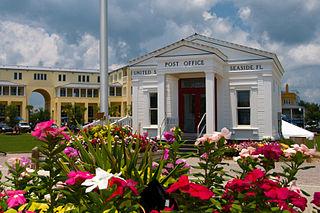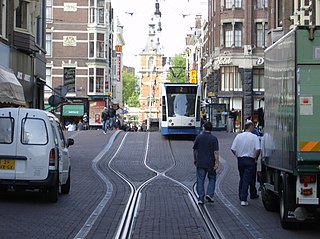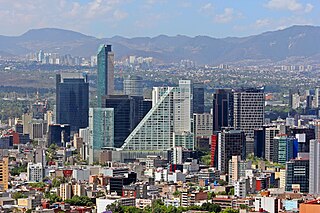
Gentrification is the process of changing the character of a neighborhood through the influx of more affluent residents and businesses. It is a common and controversial topic in urban politics and planning. Gentrification often increases the economic value of a neighborhood, but the resulting demographic displacement may itself become a major social issue. Gentrification often sees a shift in a neighborhood's racial or ethnic composition and average household income as housing and businesses become more expensive and resources that had not been previously accessible are extended and improved.

Smart growth is an urban planning and transportation theory that concentrates growth in compact walkable urban centers to avoid sprawl. It also advocates compact, transit-oriented, walkable, bicycle-friendly land use, including neighborhood schools, complete streets, and mixed-use development with a range of housing choices. The term "smart growth" is particularly used in North America. In Europe and particularly the UK, the terms "compact city", "urban densification" or "urban intensification" have often been used to describe similar concepts, which have influenced government planning policies in the UK, the Netherlands and several other European countries.

New Urbanism is an urban design movement that promotes environmentally friendly habits by creating walkable neighbourhoods containing a wide range of housing and job types. It arose in the United States in the early 1980s, and has gradually influenced many aspects of real estate development, urban planning, and municipal land-use strategies. New Urbanism attempts to address the ills associated with urban sprawl and post-Second World War suburban development.

Urban renewal is a program of land redevelopment often used to address urban decay in cities. Urban renewal involves the clearing out of blighted areas in inner cities to clear out slums and create opportunities for higher class housing, businesses, and other developments. In the United States the term technically refers only to a federal program in the middle-to-late 20th Century, but colloquially is sometimes used to refer to any large-scale change in urban development.

Urban sprawl is defined as "the spreading of urban developments on undeveloped land near a more or less densely populated city". Urban sprawl has been described as the unrestricted growth in many urban areas of housing, commercial development, and roads over large expanses of land, with little concern for very dense urban planning. Sometimes the urban areas described as the most “sprawling” are the most densely populated. In addition to describing a special form of urbanization, the term also relates to the social and environmental consequences associated with this development. In modern times some suburban areas described as “sprawl” have less detached housing and higher density than the nearby core city. Medieval suburbs suffered from the loss of protection of city walls, before the advent of industrial warfare. Modern disadvantages and costs include increased travel time, transport costs, pollution, and destruction of the countryside. The revenue for building and maintaining urban infrastructure in these areas are gained mostly through property and sales taxes. As most jobs in the US are now located in suburbs generating much of the revenue, although a lack of growth will require higher tax rates.

In urban planning, transit-oriented development (TOD) is a type of urban development that maximizes the amount of residential, business and leisure space within walking distance of public transport. It promotes a symbiotic relationship between dense, compact urban form and public transport use. In doing so, TOD aims to increase public transport ridership by reducing the use of private cars and by promoting sustainable urban growth.

Suburbanization, or suburbanisation, is a population shift from historic core cities into suburbs, resulting in the formation of (sub)urban sprawl. As a consequence of the movement of households and businesses, away from city centers, low-density, peripheral urban areas grow. Suburbanization is inversely related to urbanization (urbanisation), which denotes a population shift from rural areas into urban areas.

In urban planning, infill, or in-fill, is the rededication of land in an urban environment, usually open-space, to new construction. Infill also applies, within an urban polity, to construction on any undeveloped land that is not on the urban margin. The slightly broader term "land recycling" is sometimes used instead. Infill has been promoted as an economical use of existing infrastructure and a remedy for urban sprawl. Its detractors view it as overloading urban services, including increased traffic congestion and pollution, and decreasing urban green-space. Many also detract it for social and historical reasons, partly due to its unproven effects and its similarity with gentrification.

Mixed use is a type of urban development, urban design, urban planning and/or a zoning classification that blends multiple uses, such as residential, commercial, cultural, institutional, or entertainment, into one space, where those functions are to some degree physically and functionally integrated, and that provides pedestrian connections. Mixed-use development may be applied to a single building, a block or neighborhood, or in zoning policy across an entire city or other administrative unit. These projects may be completed by a private developer, (quasi-) governmental agency, or a combination thereof. A mixed-use development may be a new construction, reuse of an existing building or brownfield site, or a combination.
Urban consolidation describes the policy of constraining further development and population growth to within the boundaries of preexisting urban areas rather than expanding outward into suburban areas. Urban consolidation seeks to increase the population density of a given urban area by expanding upward, redeveloping preexisting buildings and lots, and constructing new facilities in available spaces. It is theorized that discouraging urban sprawl and encouraging further development of housing units in preexisting urban areas will lead to a net gain in social and economic prosperity.
The EcoDensity Initiative was officially launched in 2006 in Vancouver, British Columbia, Canada, in conjunction with the World Urban Forum. The initiative was a response to deconcentration of urban land use due to urban sprawl. The initiative used density, design and land use as catalysts towards livability, affordability and environmental sustainability. Some of the program's objectives were to reduce car reliance, deliver more efficient urban land use, improve green energy systems and build a resilient and adaptable community. In high-density urban areas, utilizing the existing infrastructure and transit and community amenities tends to lead towards a more sustainable and livable state. Accordingly, EcoDensity was designed to strategically enhance densification with the primary aim of efficiently structured neighbourhoods, denser urban-patterns and increased affordable housing.

An overspill estate is a housing estate planned and built for the housing of excess population in urban areas, both from the natural increase of population and often in order to rehouse people from decaying inner city areas, usually as part of the process of slum clearance. They were created on the outskirts of most large British towns and during most of the 20th century, with new towns being an alternative approach outside London after World War II. The objective of this was to bring more economic activity to these smaller communities, whilst relieving pressure on overpopulated areas of major cities. The Town Development Act 1952 encouraged the expansion of neighbouring urban areas rather than the creation of satellite communities. The authorities wished to divert people living in poor conditions within highly populous cities to better conditions on the outskirts of these cities. Overspill not only involves moving people to a new area, but requires industry and employment to follow. Often the industries and resources took longer to migrate than the people, hence there were a number of issues surrounding early overspill projects. Slum clearance tenants often had problems with the move, since it separated them from extended family and friends, needed services were often lacking, and only the better off workers could afford the extra cost of commuting back to their jobs. Another criticism was that the new estates occupied what had been productive agricultural land.

Land recycling is the reuse of abandoned, vacant, or underused properties for redevelopment or repurposing.
The gentrification of Vancouver, Canada, has been the subject of debate between those who wish to promote gentrification and those who do not.
Complete communities is an urban and rural planning concept that aims to meet the basic needs of all residents in a community, regardless of income, culture, or political ideologies through integrated land use planning, transportation planning, and community design. While the concept is used by many communities as part of their community plan, each plan interprets what complete community means in their own way. The idea of the complete community has roots in early planning theory, beginning with The Garden City Movement, and is a component of contemporary planning methods including Smart Growth.
Municipal disinvestment is a term in the United States which describes an urban planning process in which a city or town or other municipal entity decides to abandon or neglect an area. It can happen when a municipality is in a period of economic prosperity and sees that its poorest and most blighted communities are both the cheapest targets for revitalization as well as the areas with the greatest potential for improvement. It is when a city is facing urban decay and chooses to allocate fewer resources to the poorest communities or communities with less political power, and disenfranchised neighborhoods are slated for demolition, relocation, and eventual replacement. Disinvestment in urban and suburban communities tends to fall strongly along racial and class lines and may perpetuate the cycle of poverty exerted upon the space, since more affluent individuals with social mobility can more easily leave disenfranchised areas.
Gentrification, the process of altering the demographic composition of a neighborhood usually by decreasing the percentage of low-income minority residents and increasing the percentage of typically white, higher-income residents, has been an issue between the residents of minority neighborhoods in Chicago who believe the influx of new residents destabilizes their communities, and the gentrifiers who see it as a process that economically improves a neighborhood. Researchers have debated the significance of its effects on the neighborhoods and whether or not it leads to the displacement of residents. There are some researchers who claim that the loss of affordable housing mainly impacts the poorer minority residents and causes them to have to move out of their neighborhoods which destabilizes their cultural communities. However, critics say that since gentrification often excludes highly black neighborhoods, those residents are prevented from benefiting from any of the positive effects such as redevelopment and neighborhood investment. Factors associated with and used to measure gentrification in Chicago are changes in the number of residents with bachelor's degrees, median household income, racial composition, visual observations, and the presence of coffee shops. Historically, the emergence of urban black and Latino neighborhoods in Chicago during the 1950s through the 1970s were made possible because of the waves of white residents moving out into more suburban neighborhoods. There have been phases of gentrification in Chicago of various neighborhoods, some of which were in 1990s and in 2007–2009. Gentrification debates in Chicago have been mostly focused around the gentrification of Chicago's historically Latino or black neighborhoods. Generally, these neighborhoods are located near the central urban downtown areas and along the east side of the city.
Environmental, ecological or green gentrification is a process in which cleaning up pollution or providing green amenities increases local property values and attracts wealthier residents to a previously polluted or disenfranchised neighbourhood. Green amenities include green spaces, parks, green roofs, gardens and green and energy efficient building materials. These initiatives can heal many environmental ills from industrialization and beautify urban landscapes. Additionally, greening is imperative for reaching a sustainable future. However, if accompanied by gentrification, these initiatives can have an ambiguous social impact. For example, if the low income households are displaced or forced to pay higher housing costs. First coined by Sieg et al. (2004), environmental gentrification is a relatively new concept, although it can be considered as a new hybrid of the older and wider topics of gentrification and environmental justice. Social implications of greening projects specifically with regards to housing affordability and displacement of vulnerable citizens. Greening in cities can be both healthy and just.

Mexico City has massively been expanding its urban fabric and population density, becoming the fifth largest city in the world. A combination of neoliberal policies, complex geographic location, socio-economic disparities and inefficient strategies, have influenced the process of gentrification in the city. The combination of numerous megaprojects and inefficient city-planning strategies have led to dysfunctions in circulation, community allocation and equal access to resources. In consequence, middle and low-income communities have been directly or indirectly alienated and challenged to adapt to a complex and evolving urban environment.

The urban renewal of Sydney is an ongoing land redevelopment process that is creating and reviving new urban centres across Sydney, Australia. Urban renewal refers to the refurbishment of derelict buildings, streets or neighbourhoods and is accompanied with the process of gentrification attributed by changes in land use and deindustrialisation of areas. In 2020, there are several projects underway and planned including Barangaroo, The Bays Precinct and Green Square.












